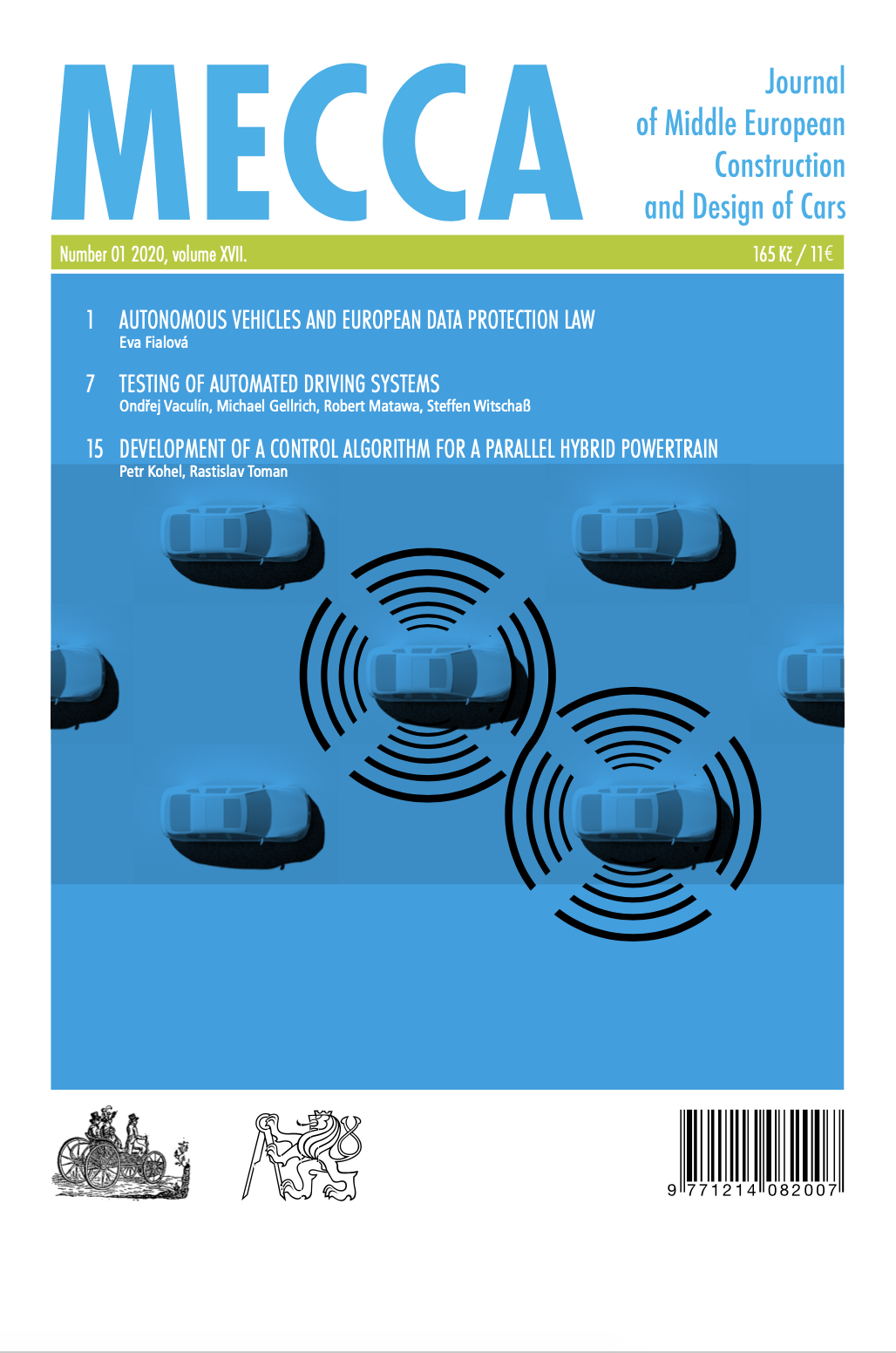DEVELOPMENT OF A CONTROL ALGORITHM FOR A PARALLEL HYBRID POWERTRAIN
DOI:
https://doi.org/10.14311/mecdc.2020.01.03Keywords:
HYBRID ELECTRIC VEHICLE, PARALLEL HYBRID POWERTRAIN TOPOLOGY, ENERGY MANAGEMENT STRATEGY, HEURISTIC CONTROL STRATEGY, CONTROL ALGORITHMAbstract
The current legislation calls for fast electrification of vehicle powertrains, since it is necessary to fulfil the CO2 requirements for the vehicle fleets. The hybrid electric vehicles (HEV) with parallel powertrain topologies – together with pure battery electric vehicles (BEV) – are the most common ways of electrification. However, the HEV powertrain – opposed to the BEV or conventional powertrain – poses an interesting challenge associated with the control system design to achieve the ideal power split between an internal combustion engine (ICE) and electrical machines (EM) during the whole vehicle operation.
The presented paper sums up the specific functions and requirements on a control system, together with the description of general control strategy options for a HEV powertrain. The proposed control strategy then combines heuristic rules with a suboptimal numerical control method, calculating the optimal power split ratio based on the efficiencies of ICE and EMs. This control strategy is built into a modular algorithm in Matlab/Simulink for two different parallel HEV powertrain topologies: P2 and P0P4. It is subsequently coupled with a vehicle models created in GT-Suite environment and tested on a WLTC homologation driving cycles. The following simulation tests show the fuel consumption reduction potential for chosen HEV topologies working in hybrid modes, in comparison to a base operation with conventional mode only. Yet, the heuristic rules can be further optimized to obtain even better overall results.
Současná legislativa tlačí výrobce vozidel k okamžité elektrifikaci pohonu, protože je to v tuto chvíli jediná možnost, jak dostát požadavkům na flotilové emise CO2. Nejběžnější formou elektrifikace pohonu jsou v dnešní době vozidla s paralelním hybridním pohonem anebo bateriové elektromobily. Nicméně hybridní pohon, na rozdíl právě od konvenčního nebo čistě elektrického pohonu, představuje zajímavé výzvy spojené s návrhem řídicího algoritmu, který musí v každém okamžiku zajišťovat optimální rozdělení výkonu mezi spalovací motor a elektromotor.
Tento článek v úvodu krátce shrnuje specifické funkce a požadavky na takový řídicí algoritmus, společně s obecným přehledem možných řídicích strategií hybridních vozidel. Následně je navržena řídicí strategie kombinující heuristická pravidla se suboptimální numerickou metodou, která vypočítává parametr optimálního dělení výkonu na základě účinností spalovacího motoru a elektromotoru. Na základě navrhnuté strategie je v programu Matlab/Simulink vytvořen modulární řídicí algoritmus pro dvě paralelní hybridní topologie: P2 a P0P4, který je následně propojen s modely vozidel vytvořenými v simulačním prostředí GT-Suite a testován v homologačním cyklu WLTC. Nakonec je prezentováno několik testů řídicího algoritmu, které demonstrují úsporu paliva vybraných topologií hybridního vozidla pracujících v hybridních režimech, ve srovnání s provozem pouze v konvenčním režimu pohonu. Avšak heuristická pravidla mohou být dále optimalizována, s cílem dosáhnout ještě příznivějších celkových výsledků.
References
KOHEL P. Návrh řídicího algoritmu paralelního hybridního vozidla, Master thesis, CTU in Prague, Faculty of Mechanical Engineering, 2019.
GUZELLA, Lino a Antonio SCIARETTA. Vehicle Propulsion Systems: Introduction to Modelling and Optimization. Third Edition. Heidelberg: Springer, 2013.
ISBN 978-3-642-35913-5.
ECKSTEIN, Lutz. Alternative and Electrified Vehicle Propulsion. 2th Edition. Aachen: fka
Forschungsgesselschaft Kraftfahrwesen mbH Aachen, 2016.
ISBN 978-3-940374-99-8.
SPICHARTZ, P., P. DOST a C. SOURKOUNIS. Recuperation
Strategies for Hybrid Electric Vehicles. 2014
th International Conference on Ecological Vehicles and Renewable Energies, EVER 2014. 1-7. 10.1109/ EVER.2014.6844100.
FLECKNER, Marco. Strategien zur Reduzierung des Kraftstoffverbrauchs für ein Vollhybridfahrzeug. Aachen, 2010. Doktorarbeit. RWTH Aachen Universität, Institut für Kratfahrzeuge.
Mustafa, R., Schulze, M., Eilts, P., and Küçükay, F.,
„Intelligent Energy Management Strategy for a Parallel Hybrid Vehicle,“ SAE Technical Paper 2014-01-1909, 2014, https://doi.org/10.4271/2014-01-1909.
CHRENKO, Daniela et al. (2015). Novel Classification of Control Strategies for Hybrid Electric Vehicles. 1-6. 10.1109/VPPC.2015.7352985.
Goerke, D., Bargende, M., Keller, U., Ruzicka, N. et al.,
“Optimal Control based Calibration of Rule-Based Energy Management for Parallel Hybrid Electric Vehicles,” SAE Int. J. Alt. Power. 4(1):178-189, 2015, https://doi.org/10.4271/2015-01-1220.
MACEK,Janetal.OptimumLimitsofMotorVehicleDriving. In: KOKA 2017. Liberec: Technical University of Liberec, 2017, s. 111-124. ISBN 978-80-7494-354-6.
MACEK, Jan et al. Optimization Tool for Hybrid Vehicles. In: KOKA 2018. Nitra: Slovak University of Agriculture in Nitra, 2018, s. 6 – 20. ISBN 978-80-552-1880-9.
Bao, R., Avila, V., and Baxter, J., “Effect of 48
V Mild Hybrid System Layout on Powertrain System Efficiency and Its Potential of Fuel Economy Improvement,” SAE Technical Paper 2017-01-1175, 2017, https://doi.org/10.4271/2017-01-1175.
Schweighofer, B., Wegleiter, H., Zisser, M.,
Rieger, P. et al., “Assessment of Minimum Fuel Consumption Operation Strategy for Hybrid Powersport Drive-Trains by Means of Dynamic Programming Method,” SAE Technical Paper 2016-32-0015,
, https://doi.org/10.4271/2016-32-0015.
Dextreit, C., Assadian, F., Kolmanovsky, I., Mahtani, J.
et al., “Hybrid Electric Vehicle Energy Management Using Game Theory,” SAE Technical Paper 2008-01-1317, 2008, https://doi.org/10.4271/2008-01-1317.
SUNDSTRÖM, Olle, GUZELLA, Lino a SOLTIC, Patrik. (2008). Optimal Hybridization in Two Parallel Hybrid Electric Vehicles Using Dynamic Programming. 4642-4647. 10.3182/20080706-5-KR-1001.00781.
Downloads
Published
Issue
Section
License
Authors who publish with this journal agree to the following terms:1. Authors retain copyright and grant the journal right of first publication with the work simultaneously licensed under a Creative Commons Attribution License that allows others to share the work with an acknowledgement of the work's authorship and initial publication in this journal.
2. Authors are able to enter into separate, additional contractual arrangements for the non-exclusive distribution of the journal's published version of the work (e.g., post it to an institutional repository or publish it in a book), with an acknowledgement of its initial publication in this journal.
3. Authors are permitted and encouraged to post their work online (e.g., in institutional repositories or on their website) prior to and during the submission process, as it can lead to productive exchanges, as well as earlier and greater citation of published work (See The Effect of Open Access).

